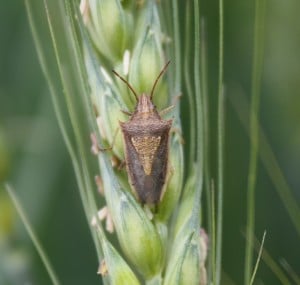I’ve not had any calls this week on the presence of armyworms or cereal leaf beetles in wheat, and I’ve only seen low numbers in the few fields I have visited. A previous article provides some detail on the management of these pests. Remember that the defoliation of either pest will have little impact on yield once wheat passes the milk stage. We will be mostly out of the woods if we can make it a couple of more weeks without any major blow ups. Until then, continue to scout!
I should also mention a few calls on rice stink bug (pictured below). This insect and the brown stink both can both be found feeding in wheat heads. The numbers is takes to justify treatment are almost astronomical (see related article by Dr. Angus Catchot, Mississippi State University). The threshold is 1 stink bug/5-10 heads during the milk and soft dough stages.

On a separate subject, we are getting some interesting data from our wheat tests that were sprayed with insecticide (Karate @ 1.5 oz/acre) for aphids during early February. Despite the low numbers of aphids that were present at the time of application, we have observed an 80-90% reduction in symptoms of barley yellow dwarf virus from this one spray. This includes a test on an insecticide treated (NipsIt) and untreated wheat seed. Indeed, the results are most obvious on the treated seed, but it was planted considerably earlier than the other test. It will be interesting to see if this translates into yield, but previous studies have indicate and 3 – 12 bushel yield response in similar scenarios.

